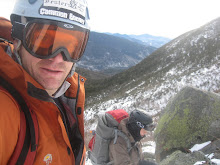
The Christmas gifts in the picture sum up alot of what I'm about. I got alot of cool stuff including a louder Ipod boombox and a big toolbox for the garage but these gifts are among the most interesting. They are, left to right: Laura and Guy Waterman's "Yankee Rock & Ice", an antique doube-shot glass, a FoxPro "Skyote" coyote call, and Rollins' "Get in the Van" chronicling his time with Black Flag.
Laura and Guy Waterman's "Yankee Rock & Ice: A History of Climbing in the Northeastern United States": Both this and "Get in the Van" are books I've been wanting to read for a long time but somehow never got around to it. I admit to having an inordinate interest in the history of the rock and ice climbs that I actually get to climb (and some I won't ever climb). It adds something to the experience for me. Some people don't want to know anything about what they're gonna climb: no move beta, no gear beta, no history... they want it to be pristine. I can understand that. I like figuring out the moves and the gear (although I'll also admit to being nosy about any (relatively) obscure but critical pieces of gear "Oh, a #4 Camalot is handy for protecting the step-out move on 'High Exposure'? Good, I typically leave that heavy hunk of metal behind."), but the history? I want to know it all. I want to know that by the Pebbles Boulders -- very near where I had my first Trad Lead (Gunks' "Belly Roll") -- that someone committed suicide by climbing then jumping off the cliff. I want to know that the "Black Dike" was a coveted first lead when modern ice tools were giving pioneers the ability to venture onto more and more vertical terrain. I want to climb "Chouinard's Gully" and "Pinnacle Gully" in full awareness of what those climbs meant to past generations (who are likely still climbing harder than I am). That's part of why I like S. Peter Lewis' "Climbs of the Northeast". He's an interesting writer that gives a little bit of history or a personal story for each of the climbs in the book. That's why it's the only guidebook I've ever read cover-to-cover. I'm hoping "Yankee Rock & Ice" will fill in the gaps. BTW, it's a companion book to "Forest and Crag" which chronicles non-technical hiking and exploration in the Northeast... maybe next Christmas?!
If you don't know anything about Guy and Laura Waterman, let me give you some background - at least the way I remember it. I read his biography "Good Morning Midnight" (Great title, right? But just read the short version here). Tough read, not particular well written and if I hadn't been a new dad I probably wouldn't have finished the book. However I was a new dad and he wasn't -- apparently -- a particularly good father. At the time of his death, none of his kids were still talking to him and one son had committed suicide in a fashion that portended the death of Guy himself. Jon Waterman (NOT Jonathon Waterman) -- a name familiar to people who have read anything of Alaska Range mountaineering history because of his infamous 5 month solo up and over Mount Hunter and because he basically committed suicide by continuously walking unroped across crevasse-laced glaciers -- was Guy's son. If I remember correctly (a distinct possibility), another son was crippled when his leg was caught under a freight train he was hopping. Guy and Laura committed to a subsistence homesteading lifestyle in, I believe, Vermont (I'm going on memory here). They lived in a cabin in the woods ( called "Barra" I believe) built around a piano miles from town and accessible only by footpath. They wrote this book while living there. Eventually, he and Laura built another home closer to town and it slowly became obvious that this was "Laura's home". Meaning, of course, that Guy wasn't going to be around much longer. Shortly after it was finished he hiked up to his favorite part of the Northeast Mountains. A place that he had spent a lifetime exploring both on and off-trail in all four seasons, sat down, and died of exposure near Franconia Notch. Crazy. I can't wait to read this book, but it will take a back seat to my back rehab books (in the meantime I'll skip ahead to whatever climbs I'm doing next weekend...Trap Dike!).
Well , this got a little long so I'll get to the shot glass, the coyote call, and Rollins' "Get in the Van" later.
SOUNDTRACK: Operation Ivy's "Unity". For no other reason than that's what is playing right now on my Ipod. Op Ivy is go-to music for me, though. Never a bad time for Op Ivy. Summer BBQ? Yeah, Op Ivy sounds so good, let's drink! Tooling around the mountains by myself on an introspective winter night? Sure, Op Ivy is perfect. Groundbreaking combination of ska and punk. Ok, one quick story. I stopped at the 7-11 on my way home from work one time in Norristown and I go in to pay for the gas and the guy behind the counter has the album cover from "Energy" tattoed on his forearm.
Me: "Nice Op Ivy tatto."
Him: "I'm surprised a guy in a suit knows who they are." (bear in mind I'm wearing a pair of khakis and a button down shirt, no tie, no jacket and I'm driving a beat-up 1987 Toyota pick-up with aluminum siding riveted over the gaping rust holes to pass inspection).
Me: "Umm... yeah, even The Man likes Op Ivy."
















 Celebrate:
Celebrate:
